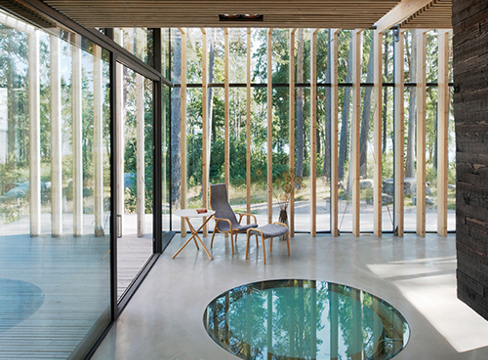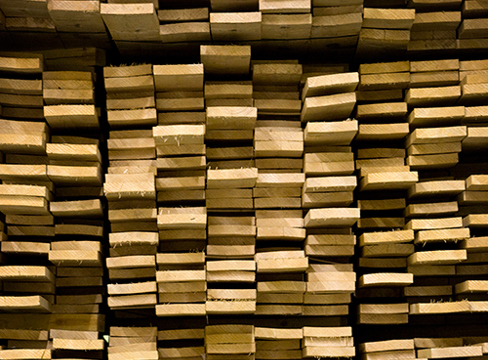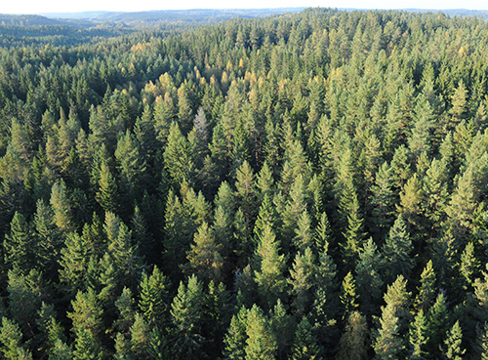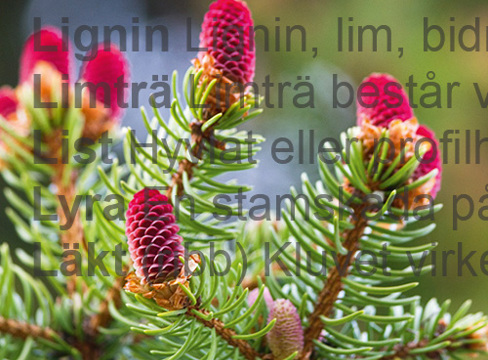Regarding use of blue- stained wood
Storm felling and insect damage in southern Sweden and Central Europe are expected to result in an increase in blue- stain in wood. Blue- stain mainly affects the timber's ability for water uptake (permeability). This can have negative effects on surface treatment when timber is processed and can increase the risk of biological damage to timber in outdoor use. This text aims to clarify when wood with blue stain can be used without risk, when extra attention should be given and when wood with blue stain should not be used.
What is causing blue- stain?
Blue- stain is caused by the Ophiostomatales fungi, a type of fungi in the class of Sordariomycetes, spore- sac fungi. The hyphae are brown and give the wood a bluish tone as they grow inside the wood. Blue- stain does not cause a reduction in the strength of the wood.
Blue- stain occurs as log stain where the damage occurs in standing forest or in timber before sawing, or as yard stain in boards and planks which is caused by traditional yard seasoning taking too long. Yard stain can also occur if wood is stored for too long between sawing and drying. Log stain is generally more extensive and can mean that all sapwood has been discoloured. Yard stain is usually more local in the wood and can be seen, for example, in patches of the wood surface under drying sticks where evaporation of moisture has been blocked and the drying process slowed down.
In order for blue- stain to thrive in wood, oxygen and water are required. In the growing tree, the development of blue- stain is prevented by the limited supply of oxygen, partly because the moisture ratio is so high that the water itself blocks the air supply, and partly because the cell structure is intact. If the tree is exposed to damage so that the wood begins to dry and the structure is opened, blue- stain starts to grow. Likewise, damage to the bark during felling means that blue- stain can occur.
Blue- stain damage also often occur in connection with bark beetle infestation. Bark beetles not only cause a local dehydration and open the structure so air becomes available, but also spread spores and fungi to the tree. Blue- stain growth can occur even at low temperatures but is fastest when the temperature is around 25 degrees.
Development of blue- stain in sawlogs is reduced by limiting the time between felling and sawing, and if longer storage time is needed, by preventing the logs from drying by storing the logs in water or by spraying the stored logs.
Growth of blue- stain only occurs above fibre saturation, that is, at moisture content levels higher than 30 %. This has the effect that blue- stain cannot grow in sawn timber that has been dried unless it is exposed to extreme moisture levels, such as prolonged soaking in water.
Differences between blue- stain and mould growth
The discoloration of the wood means that blue- stain can sometimes be mis- interpreted as mould. However, the differences between the two phenomena are great. Blue- stain requires a high moisture content in the wood, it grows inside the wood and it does not emit harmful substances to the surrounding air. Blue- stain therefore has no known negative effects on human health.
Mould, on the other hand, grows on surfaces of different materials. The required moisture for the mould to grow can be taken from the ambient air, and the nutritional needs can be met by dirt falling onto the surface. Mould also releases spores and various chemical substances into the surrounding air, substances that can have a negative impact on health.
The effect of blue- stain fungus on the wood
Blue- stain does very little damage to the cell wall and therefore has a negligible effect on the strength of the wood.
Blue- stain damage increases the timber's water permeability, which means that the timber's water - absorbing ability increases. If the damaged wood is exposed to rain, it will absorb water faster than unaffected wood.
Blue- stain increases the permeability of the wood for liquid water, but it does not affect the chemistry of the cell wall. This has the effect that it probably does not affect the equilibrium moisture content of the wood, blue- stained wood does not absorb more water vapour from the surrounding air.
The appearance of blue- stain varies between different parts of the wood, which means that both the colour and the permeability can vary greatly between different parts of the same piece of wood.
It is commonly accepted that blue- stain can function as a gateway for rot in the wood, as the wood can show increased water uptake at the same time that the structure is opened up. Blue- stained wood can also dry more slowly after wetting compared to undamaged wood.
Where can you use blue-stained wood?
Blue- stain affects the wood's appearance and water uptake, but has negligible effects on the wood strength. Blue-stain damaged wood can therefore be used without restriction in constructions where the wood is not seen, but protected from moisture. Typically, blue- stain damaged wood can be used for interior constructions such as internal stud- walls, glulam beams, solid wood constructions or trusses.
When to be careful?
If the building is built without weather protection, special attention should be paid to the risk of increased moisture levels due to precipitation. The higher water uptake of the blue- stain damaged wood means that more water will be absorbed by the wood compared with undamaged wood, increasing the risk of resulting moisture damage.
Where not to use blue-stained wood?
As blue- stained wood has increased permeability, it should not be used in parts of the structure that are exposed to rain such as windows, outdoor panels, roof fittings, and similar products. The increased water uptake of these parts of a construction leads to increased risk of microbiological attacks such as mould and rot, as well as shortening the service life of surface treatments.
The colour changes and the variation in permeability also have the effect that blue- stained wood is not suitable for carpentry requiring glazing, or a semi-transparent surface treatment.






